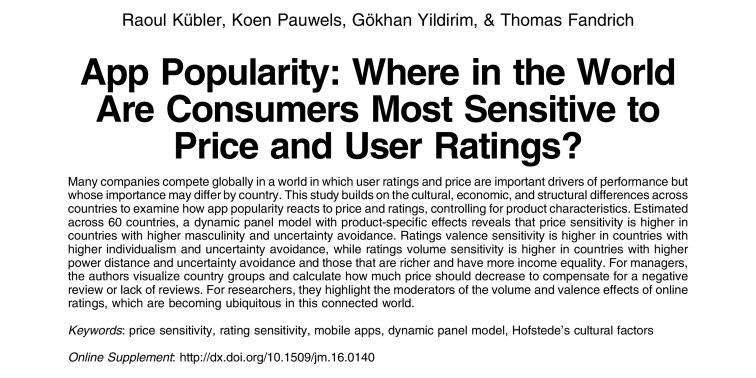Professor Kübler publishes research on cross-cultural price and eWoM sensitivities in Journal of Marketing

Professor Kübler published a study on how a country’s culture and socio-economic background influences consumers’ price- and electronic word of mouth sensitivities in the prestigious Journal of Marketing, which is considered to be the leading academic marketing journal.
Together with Professors Koen Pauwels (Northeastern University, Boston) and Gökhan Yildirim (Imperial College, London) as well as Dr. Thomas Fandrich, founder and CTO of quantilope, he analyzed a set of the top 20 selling apps in the world. “Together we extracted more than 250,000 data points for 60 countries from Apple’s famous App-Store,” explains Professor Kübler. “Using an innovative multi-level econometric model that accounts for each country’s specific setting, we were able to obtain country-specific estimates for price- and word-of-mouth sensitivities.”
The team was surprised to see very heterogeneous effects across countries for price promotions, rating volume as well as rating valence. Despite having a true globalized product such as gaming-, sport-, business-, and health-apps, sensitivities tremendously vary across countries. “This made us even more curious, so that we started to collect country-specific data such as e.g. a population’s average risk aversion, power distance, average income, and income distribution, as well as mobile internet accessibility and smartphone penetration, to see if we could systematically explain the identified differences,” continues Professor Kübler.
In this second analytical step, the international research team was able to find significant effects, pointing out that mostly the cultural factors drive differences, whereas socio-economic factors such as e.g. GDP and education level play no or only a minor role. However, price sensitivity is higher in countries with higher masculinity and uncertainty avoidance (such as Italy and Malaysia). The first finding is likely due to the fact that the apps, which were mostly games, align with stereotypically masculine values.
Rating valence sensitivity is higher in countries with higher individualism and uncertainty avoidance (such as the US, France, and Czech Republic). Individualistic cultures place more stock in anonymous ratings, whereas collectivist cultures favor word of mouth. Similarly, customers seeking to avoid uncertainty depend on ratings to make purchase decisions.
Ratings volume sensitivity is higher in countries with higher power distance and uncertainty avoidance (such as Luxembourg, El Salvador, and Portugal). App popularity, with correspondingly high ratings, increases trust with uncertain customers and wealthy customers, who are more willing to trust anonymous strangers than those in less affluent markets.
The research team found the highest price and ratings volume sensitivities for countries high in uncertainty avoidance but low in income inequality (such as Thailand). The lowest price and ratings volume sensitivities were found in case of countries low in uncertainty avoidance but high in income inequality (such as Spain).
“Our research provides important insights for app developers,” explains Professor Kübler. “Launching an app costs by average 140,000 USD and a well-managed app has an average monthly revenue averaging $3,200 to $8,100. Such apps can be easily buried among millions of competitors in app stores. Fine-tuning pricing and rating strategies can help mean the difference between success and failure. We provide in our paper detailed tables and figures, highlighting sensitivities in all 60 countries. In addition we estimate with the help of culture and socio-economic factors sensitivities for all countries worldwide, even for those not included in our sample and report these in the paper, too.“ Developers trying to adapt their price promotions or to react to rating changes can use this information to localize their marketing efforts.“ Even though our data is limited to mobile apps and the Apple App Store, we strongly believe that our findings apply to other similar platforms such as e.g. Gaming Platforms like Steam, the different Android based App stores, but also to any sort of digital product that sells online,” concludes Professor Kübler.
The study “App Popularity: Where in the World Are Consumers Most Sensitive to Price and User Ratings?“ with all materials can be found here.
Log Ratio of Estimated Ratings Valence and Volume Effects on App Popularity:

World Map of Estimated and Predicted Price Sensitivities:

World Map of Estimated and Predicted Ratings Valence Sensitivities:


